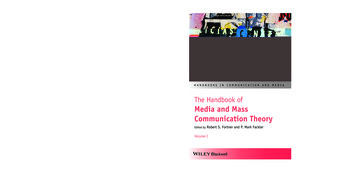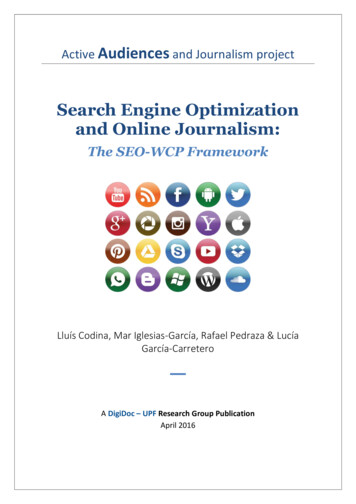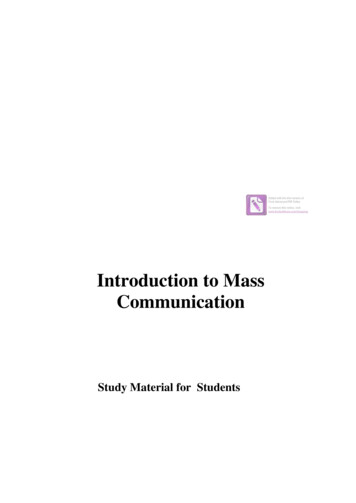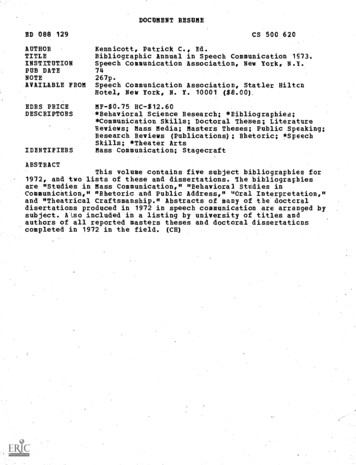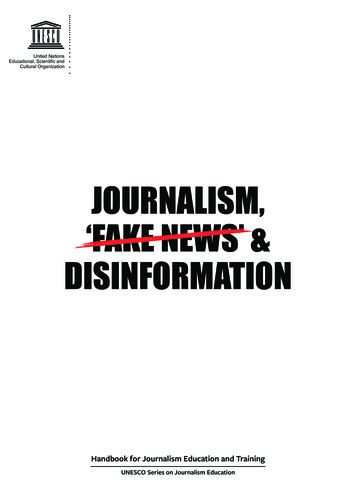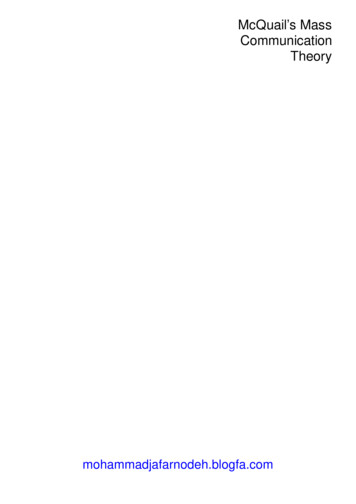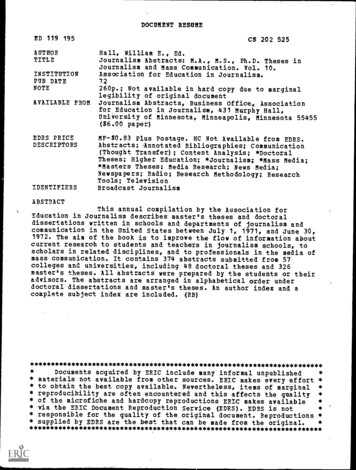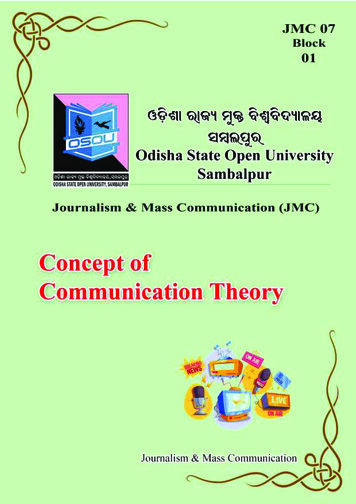
Transcription
JOURNALISM & MASS COMMUNICATIONJMC-07CONCEPT OF COMMUNICATIONTHEORYBlock1Concept of Communication TheoryUnit-1Importance of Communication Theory, Wwo Step Flow & MultistepFlow Theory, Individual Difference Theory,Unit-2Selectivity & Gatekeeping Theory, Diffusion of Innovation Theory,Personal Influence TheoryUnit-3Authoritarian Theory, Libertarian Theory, Communist MediaTheory, Social Responsibility TheoryUnit-4Development Media Theory, Democratic Participation Theory,Communication Convergence.1
Expert Committee MembersProf. Mrinal ChatterjeeProfessor, IIMC, DhenkanalChairmanDr. Dipak SamantaraiDirector, NABM, BhubaneswarMemberDr. Asish Kumar DwivedyAsst. Professor (Communication)Studies, SoA University, BhubaneswarMemberSudhir PatnaikEditor, SamadrustiMemberSujit Kumar MohantyMemberAsst. Professor (Journalism & Mass Communication)Central University of Orissa, KoraputJyoti Prakash MohapatraMember ConvenorAcademic Consultant (Journalism & Mass Communication),Odisha State Open University, SambalpurCourse Writer:Course EditorRuby NandaMedia AcademicianSanjay Kumar SahooMedia AcademicianMaterial Production :Dr. JayantaKar SharmaRegistrarOdisha State Open University, Sambalpur OSOU, 2017. Promoting Use and Contribution ofOpen Education Resources is made available under aCreative Commons Attribution-ShareAlike inted bySri Mandir Publication, Sahid Nagar, Bhubaneswar2
JMC-07Block1ContentUNIT 11.0Unit structure051.1Learning Objectives051.2Introduction051.3Importance of Mass communication theory061.4Brief History of Mass Communication Theory081.5Hypodermic Theory101.6Personal Influence Theory111.7Individual Difference Theory131.8Check Your Progress16UNIT 22.0Unit structure172.1Learning Objectives172.2Introduction182.3Gate keeping Theory182.4Diffusion of Innovation Theory232.5Agenda Setting Theory262.6Framing Theory292.7Check your progress31UNIT 33.0Unit structure323.1Learning Objectives323.2Introduction333.3Authoritarian Theory333.4Libertarian Theory343.5Soviet Communist media Theory373.6Social Responsibility Theory413.7Check your Progress433
UNIT 44.0Unit structure444.1Learning Objectives444.2Introduction454.3Development Media theory454.4Democratic Participation theory504.5Communication/ Media Convergence Theory524.6Check Your Progress57FURTHER READINGS58ANSWER TO CHECK YOUR PROGRESS58MODEL QUESTIONS604
CONCEPT OF COMMUNICATION THEORYUNIT – I1.0 UNIT STRUCTURE1.1Learning Objectives1.2Introduction1.3Importance of Mass communication theory1.4Brief History of Mass Communication Theory1.5Hypodermic Theory1.6Personal Influence Theory1.6.1 Two step flow1.6.2 Multistep flow theory1.7Individual Difference Theory1.7.1 Selective Exposure1.7.2 Selective Perception1.7.3 Selective Retention1.8Check Your Progress1.1 LEARNING OBJECTIVESIn this unit we will briefly study the history and importance of mass communicationTheory. We will also discuss three early theories of Mass Media: Hypodermic orBullet Theory, Individual Differences Theory and Personal Influence theory.1.2 INTRODUCTIONMass Communication has an influential role in modern society. The Theories of MassCommunication explains the impact of mass media on society and public. The study ofmass communication has led to the formulation of many theories. Since early 1900s,the mass communication theories are ever changing, because of changing technologyand academic focus. Let us discuss why we should study Mass Communication Theory.Odisha State Open University5
CONCEPT OF COMMUNICATION THEORY1.3 IMPORTANCE OF MASS COMMUNICATIONTHEORYMass Communication has been evolving through the ages. The immense technologicalchange has completely changed or reinvented the way mass media is distributed andconsumed today. New communication technologies are rapidly filling the gap betweentelephone and television. Technologies today are allowing the consumer more andmore control over the creation and consumption of media. This has led to immensechanges in the way the media industry affects us in our social relationships and ourpersonal lives. According to Chaffee (2001) ‘Contemporary media allow a greaterquantity of information transmission and retrieval, place more control over both contentcreation and selection in the hands of their users, do so with less cost to the averageconsumer.’A Mass Communication theory thus helps us understand these changes and its impacton our lives. Mass Communication theorists are, therefore, social researchers who tryto apply scientific methods to study human behavior.Mass Communication theory strives to formulate statements or propositions that willprovide some explanation about usage, effect and impact of media on mankind.The theory seeks to explain the effects of mass communication on society, audiencesand people. These effects can either be intentionally or unintentionally applied to themessages by the sender.Theory tries to explain the uses to which people put mass communication. Studyinguses recognizes the active role of the audience within the process of mass communication.Mass Communication theory also seeks to explain learning from the mass media. Ittries to find answers to questions like: How do audiences learn from the media? Is itpositive or negative? Do media send a message to the audience? Definite answers arestill being searched by communication scientists.Theory explains the role of mass media in shaping audiences values and opinions. Likeit or not audiences do learn from the media, they take on the views expressed in themedia or seek out media sources which agree with and reinforce their own views.Mass Communication theories help us in finding out the relation of mass media withpower, its effect on politics, economics, culture and society, relation and effect of massOdisha State Open University6
CONCEPT OF COMMUNICATION THEORYmedia on the masses. Let us briefly learn more about them:a) Mass Media and PowerMedia has the power to bring change and set agenda. Mass communication has thepower to give a voice to an opinion and spread it. It is a powerful weapon of controllinginformation flow in the hands of its owners. It can give representation to theunrepresented. Then mass communication theories seek to study media and the powerit wields.b) Mass Media and PoliticsMass media has a great impact on the politics of a country and the world. It is knownas the fourth pillar of a democracy. A free and fair press can spread correct informationto the society. Media has the power to reshape political power. Media acts as themessenger of diverse political views. Media can be used to spread propaganda asduring the World War I and II.c) Mass Media and EconomicsMedia consumption, production and its distribution is highly dependent on economicalconditions. The process of globalization has increased by the proliferation of satellitechannels, easy access through the internet and international print media. Economicsplays an important part in how media is transmitted, what makes news and what doesnot make news. Today controlling information has become more expensive thandisseminating information.d) Mass Media and CultureMass Media reinforces stereotypes and the established social norms of a society. Itcan also bring in new ideas and break old traditions. Mass media can show a particularculture as subservient to another. Today, mass media is creating a global or convergentculture.e) Mass Media and the MassesThe relationship between mass media and masses is changing rapidly. Earlier, newswas created and the masses consumed it. Today, the consumer is the news creatorand transmitter. The reader can not only pick or choose the news they want to see,they can provide instant feedback and create news. Media creates a liberating effecton people.Odisha State Open University7
CONCEPT OF COMMUNICATION THEORY1.4 BRIEF HISTORY OF MASS COMMUNICATIONTHEORYMass Communication or Media theory can be divided into broadly four distinctiveeras from the beginning in early 19th century. The history of Mass Communicationtheories can be broadly divided into four eras: The Era of Mass Society, The Era ofLimited Effects, The Era of Cultural Theory and The Era of Meaning MakingPerspectives on Media.i.The Era of Mass SocietyThe idea of mass society developed at the latter half of 19th century, when rapidindustrialization, large scale migration took place. The social thinkers blamed the mediafor negative influences of industrialization. The dominant perspective was Mass SocietyTheory. The idea that the media are corrupting influences that undermine the socialorder and that ‘average’ people are defenseless against their influence. The theoryargues that media subverts and disrupts the existing social order. The audiences wereconsidered as passive beings.Behaviorism and Freudianism were combined to create propaganda theories whichfound the average person incapable of rational self control. The propaganda theoriesfound people to be very susceptible to manipulation by media.Harol Lasswell’s Propaganda Theory borrowed this pessimistic vision of media andtheir role in creating modern social order. Lasswell argued that during troubled periodpeople were easily affected by even crude forms of propaganda.The theories that emerged during this time were Hypodermic needle theory or Magicbullet theory.ii.The Era of the Scientific Perspective/ Limited Effects TheoryBeginning in 1940’s, Paul Lazarsfeld and other researchers started a scientific approachtowards mass communication. He carefully used empirical social research methods.He advocated conducting carefully designed, elaborate surveys and even fieldexperiments to observe media influence and measure its magnitude.By mid-1950’s the empirical media researchers after interpreting the data collectedfound that mass media was not all powerful. But various other factors such as personalrelationships and attitudes helped in resisting media. They found very little evidence tosupport mass society theorist. They concluded that the effect of media was limited onOdisha State Open University8
CONCEPT OF COMMUNICATION THEORYan individual; this was later known as the Limited Effects Theory.During the middle of 1960’s the debate between mass media society and limited effectswas over with the empirical evidence in support for the latter. Many communicationscientists stopped looking for powerful media effects and concentrated instead ondocumenting minimal, limited effects.The limited effects theory says that change in attitude due to media effects is thereforelimited and rare. The World War II provided the best laboratory for propagandaresearch and Attitude Change theories. Carl Hovland and his team did intenseexperiments on attitude change.One of the central tenants of attitude change theory, cognitive consistency, was adoptedby mass communication theorists who gave rise to the Dissonance theory. The theoryargues that when confronted by new/conflicting information people experience a kindof mental discomfort.According to Kapler, selective processes protect media consumers from its impact.Attitude change researchers studied three types of selectivity: selective exposure,selective retention and selective perception. Information Flow theory, John Klapper’sphenomenistic theory or reinforcement theory are some of the other theories of theage.The limited effect communication researchers felt that there was nothing left to study.But many disagreed and the limited effects theory was challenged from various fronts.iii.The Era of Cultural TheoryEuropean social theorists known as the neo-Marxists argued that media helped dominantand social elites promote their ideas favourable to their interests. During 1960’s and1970’s neo-Marxists in Britain developed two schools of social theory known as theBritish cultural studies and political economy theory. The British cultural studies focusedin mass media and its role in promoting hegemonic worldview and a dominant cultureamong various subordinate groups in the society. While, the political economy theoristsstudy the economic control by the elite class and show how it affects the mass media.In 1970’s, American scholars began study on popular culture including television byadapting variety of theories and research methods. Horace Newcomb in his booksTelevision: The Critical View and Television: The Most Popular Art summarizesthe work of popular culture researchers, emphasizing that popular media content,Odisha State Open University9
CONCEPT OF COMMUNICATION THEORYspecially TV programmes are much more complex then they appear on surface.iv.Emergence of meaning making perspectives on MediaWith the emergence of new technologies there has been a sea change in the waypeople consume media. These new perspectives can lead to the emergence of fourthmedia era. New perceptive are transforming about how we think about media effects,with researchers compellingly arguing that media influences individuals and impactstheir social world. Framing theories and media literacy movement bring into focushow new media has powerful effects and is challenging the individuals beliefs andattitudes.Contradicting the Limited Effects Theory at the centre of the new perspectives is thecontent creating and sharing audience. Media effect can be long term and are manyties a direct consequence of audiences’ intent. Therefore, media is being used toserve a purpose such as gather information, seek entertainment or manage moods.Thus the various meaning-making perspectives claim that the people are using mediato create meaning, to intentionally induce desired results leading to both intended andunintended results. There is a need to further study such intended and unintendedconsequences of media use.1.5 HYPODERMIC OR BULLET THEORYThe Hypodermic needle theory or magic bullet theory is one of the earliest theorieson media. The theory was developed during the WW II and is a reflection of the feargenerated by media propaganda during those times. The hypodermic needle theorystates that media has a direct, immediate and powerful effect on the audiences. Thetheory is a linear communication theory which postulates that media messages aredirected injected into the brains of the audiences.The theory suggests that mass media could directly influence a large number of peopleby ‘shooting’ or ‘injecting’ them with the information. The theory graphically suggeststhat the message in media is the bullet fired from media gun straight into the viewer’shead. Or the hidden messages in media are injected into the individual passiveaudiences.The Hypodermic needle theory was derived from three major events.First, in 1927, Harold Lasswell, an American political scientist and propaganda theoristpublished a book called Propaganda Technique in World War. Writing about theOdisha State Open University10
CONCEPT OF COMMUNICATION THEORYeffect of propaganda during World War I, Lasswell wrote that “Wilson brewed subtlepoison”, which was “injected into veins of a staggering people”Second, the Payne Fund Studies, conducted between the years 1929-1932 to studythe effect of movies on children also supported the idea that mass media had a greatimpact on the viewers. Although the studies were criticized for not following properscientific methodology they are one of the earliest and most comprehensive mediastudies. The studies found that movies had wide influence on children behaviour.Thirdly, a classic application of the theory was seen in 1938, a radio dramatization ofHG Wells’ War of the Worlds by Orson Welles and Mercury Theatre broadcast leadto mass hysteria where thousands believed that they were been attacked by Martians.Hypodermic Needle Theory talks of direct influence effect and describes theinformation is like a magic bullet injected into the targeted audiences mind. Hencemedia is dangerous and has a major impact on the consumer. It is like a drug that getsinto the audiences mental system. Hypodermic theory believes that media can manipulateaudiences at will. If an idea is constantly repeated the audiences tend it believe it,according to the theory. The Hypodermic theory is similar to mass society theory.The limitations of the theory are that it considers media as all powerful and audiencesare helpless before its assault. It also suggests that all consumers of media are sameconsumer media in a similar manner. Although the theory is no longer considered validbut it still has great influence about how we think about the influence of media.1.6 PERSONAL INFLUENCE THEORYThe personal influence theory was derived from the classic study of United StatesPresidential elections in 1940 by Paul Lazarsfeld, Bernard Berelson, and Hazel Gaudet.The two step flow of information hypothesis was derived from The People’s Choicestudy conducted in 1944 by these three social scientists. These researchers hoped tofind media directly affected the audience opinions. They were surprised to find thiswas not the case and personal contacts were mentioned more frequently than radio ornewspaper as affecting their voting preferences. The informal discussions with politicalopinion leaders helped the voters finalize their voting preferences. The personal influenceor two step theory, therefore, contradicts the hypodermic needle or magic bullet theorywhich states that people are passive consumers of media and are directly influencedby mass media.Odisha State Open University11
CONCEPT OF COMMUNICATION THEORY1.6.1 Two step flow TheoryPaul Lazarsfeld and Elihu Katz are the founders of the Two Step Theory and theirbook Personal Influence (1955) is the handbook of the functional theory. The twostep theory claims that majority of people are indirectly influenced and informed by themedia through opinions leaders in the society. The majority of people from their opinionbased on the analysis and interpretation of media messages. ‘Opinion leaders’ areinfluential and well informed personalities who when exposed to a specific media contentinterpret it and form their own opinion. They now pass on this opinion to people intheir social circle who become the ‘opinion followers’. These opinion leaders haveaccess to elite media sources as opposed to general main stream media.The two step flow of communicationmodel hypothesizes that ideas flowfrom mass media to opinion leadersand from them to a wider population.The two step flow of information‘personal influence’ means theprocess intervening between media’sdirect message and the audience’s reaction. These opinion leaders are similar to onesthey influence in interests, personality, and socio-economic status. They hold a respectedposition in the society who relies on them for ideas, information and guidance. Theyinfluence others to change their attitudes and opinions.1.6.2 Multistep flow TheoryThe Two Step Flow Theory gave way to the Multi Step Flow Theory. It was observedthat the influence from the media can be multi directional and it is not necessarilydownwards but can be upwards or even backwards to the media as well. The TwoStep Flow led to the change in name basically because of the opinion leaders who aremore than just a second hand. This caused the description “Multi Directional” becausethe multistep had to do with more than one opinion leader, they could be two, three,four, five or even six people. Many a time, the information reaching the audience isaltogether different from the original piece of information. That is, opinion leaders whopass the information add their own interpretation to it giving it a new meaning andmaking the information distorted.Odisha State Open University12
CONCEPT OF COMMUNICATION THEORYIn the figure Step 1a and 1b information through/from mass media flows simultaneouslyto the Opinion Leaders, Opinion Receivers/Seekers, and Information Receivers.Opinion Seekers are those who solicit information and advice from Opinion Leaders.Information receivers are those among the masses who neither influence nor areinfluenced by others). In Step 2, both information and influence are transmitted fromthe Opinion Leaders to the Opinion Receivers/Seekers. Step 3 completes the twoway exchange and illustrates the transfer of information and influence from OpinionReceivers to Opinion Leaders.The audiences here are active because they send feedback to the media suggesting,appreciating or criticizing things or events. There is peer to peer discussion as well,where the audiences with similar opinion share insights with each other.The multi-step flow is also called diffusion of innovations theory which gives it a newdimension and understanding. This predicts that media and interpersonal contactsprovide information and influence opinion and judgment. Its focus is on the medialetting out information and in a point where the audience may be thrown in imbalancebecause the message or information is not in consistency with their culture or beliefs.The role of the opinion leaders come to play whereby they engage in face-to-faceexplanation with the people either to advise them or help them get cognition.1.7 INDIVIDUAL DIFFERENCE THEORYIndividual differences theory or Attitude change Theory of mass communicationproposes that individuals respond differently to the mass media according to theirpsychological needs, and that individuals consume the mass media to satisfy thoseneeds. The theory gives importance to the individual audiences and states that anindividual’s values, needs, beliefs and attitudes play a major role in how they react anduse media.The individual difference theory is an important theory based on psychological approachto understand mass media effects. According to this theory, different personality variablesOdisha State Open University13
CONCEPT OF COMMUNICATION THEORYresult in different reactions to the same stimuli. In other words, the psychological makeupof a person is very much responsible for how he or she will consume media. Therefore,different people will react differently to same information or message. In other words,reaction of media message or content will differ according to motivation of audiencemembers, their predisposition to accept or reject a given message, their prior believes,values, bias, intelligence level, moods etc.A category for communication research generally known as attitude change researchhas focused on the phenomenon that different individuals may receive the same messagebut act on it quite differently. This research is grouped under the heading of selectivity.The studies of American researcher Carl Hovland in particular concluded that peopleare very selective in how they use media; in the topics they expose themselves to, inhow they interpret information, and in how they retain information obtained throughthe media.Thus, the theory points out that people are selective about their use of media. Themost important aspects of selectivity are the theories of selective exposure, selectiveperception and selective retention. Selective exposure and selective perception act asbarriers between message and effect, thus limiting the direct impact of masscommunication on people.1.7.1 Selective Exposure theorySelective Exposure means that people expose themselves and access only thosecommunications which are in accordance with their established beliefs and convictions.They tend to avoid those messages which are against their point of view. People seekout not only topics of interest to them but more importantly viewpoints with which theyexpect to agree. Thus, they use to the media to reinforce existing biases. On occasionswhen people seek out opposing points of view, they often do so for the purpose ofhearing the arguments so that they can refute it later.1.7.2. Selective Perception theorySelective perception observes that people often interpret facts to suit their existingbiases. Once the individuals have selectively exposed themselves to the messages inaccordance with their preference, they tend ‘read into’ the message whatever suitstheir needs. This process is called selective perception.Selective perception implies that the audience members tend to misinterpret mediaOdisha State Open University14
CONCEPT OF COMMUNICATION THEORYmessages according to their psychological predisposition. The famous “Mr Biggotexperiments” are classic examples which show that prejudiced people misinterpretedthe meanings of anti-prejudice propaganda in such a way that it reinforced their existingbiases.People hear what they want to hear and what they expect to hear. Thus the sameinformation may carry different meaning for different people, particularly people withdiffering political, religious, cultural, ethnic, national or other substantial differences.1.7.3 Selective Retention TheorySelective retention notes that people remember messages that support their opinionlonger than they remember opposing messages, which often unconsciously are forgottenand set aside. As with selective exposure and selective perception, selective retentionis likely to reinforce existing beliefs and attitudes. Such tendencies make it less likelythat the media can play a solo role in changing attitudes and behavior.Melvin L.De Fleur and Sandra Ball Rokeach have concluded, “from the vast availablecontent, individual members of the audience selectively attend to, interpret and retainmessages, particularly if they are related to their interest, consistent with their attitude,congruent with beliefs and supportive of their values”.To sum up, Individual Differences Theory of mass communication proposes thatindividuals respond differently to the mass media according to their psychological needs,and that individuals consume the mass media to satisfy those needs. The need may befor information (e.g. providing statistics about players and teams), integrative (offeringa sense of belonging to a group of similarly interested people), affective (e.g. by providingexcitement), or escapist (helping to release pent-up emotions).Odisha State Open University15
CONCEPT OF COMMUNICATION THEORYCheck Your Progress:1.1 What is Hypodermic Needle Theory ?1.2 Explain Two Step Theory of Mass Communication?Odisha State Open University16
CONCEPT OF COMMUNICATION THEORYUNIT – II2.0 UNIT STRUCTURE2.1Learning Objectives2.2Introduction2.3Gate keeping Theory2.3.1 Gatekeeping in Media2.3.2 Audience Gatekeeping2.3.3 Features of Gatekeeping Theory2.3.4 Criteria for News Selectivity2.3.5 Audience Gatekeeping2.4Diffusion of Innovation Theory2.5Agenda Setting Theory2.5.1 Types of agenda-setting2.5.2Limitations of Agenda setting theory2.6Framing Theory2.6.1 Types of Framework2.6.2 Framing Techniques2.7Check your progress2.1 LEARNING OBJECTIVEIn this unit we will learn about the theories which explain how media controls the flowof information. We will discuss as Gatekeeping theory, Agenda Setting Theory andFraming Theories in detail.Odisha State Open University17
CONCEPT OF COMMUNICATION THEORY2.2 INTRODUCTIONThe role of media in the social world is a very important topic for research. The earlymass media theorists were concerned with the threat of propaganda in mass media.While, the modern mass media theorist have studies the power of media to create anddisrupt social organizations. The theories Gatekeeping, Agenda Setting and Framing,which we will study in this unit, deal with how those in media decide what will be news,which news item will be given more importance and how it affects the audience. Hownews items are selected while others are rejected? How news is selected due topreconceived notions held by the journalist and editor?2.3 GATEKEEPING THEORYThe gatekeeper is the person who decides what shall pass through each of the severalgates in a process. Kurt Lewin, a German psychologist, recognized that for food to gofrom a store or a garden to the dining table, there were various decision-makingprocesses it had to pass on the way there. Entering or not entering a channel andmoving from one section of a channel to another are affected by a ‘gatekeeper’”. KurtLewin used the term "gatekeeping," to describe a wife or mother as the person whodecides which foods end up on the family's dinner table. Lewin’s research demonstratedthat not all members of a family have equal weight in making household food decisions,and that the wife,who typically shopsfor and prepares thefood controls thegates, based on avarietyofconsiderations. Thistheory of channelsand gatekeeperswas known asLewin'sFieldTheory of Social Science in 1951.Odisha State Open University18
CONCEPT OF COMMUNICATION THEORY2.3.1 Process of the Gatekeeping model:1Information moves step by step through channels. The number of channelsvaries and the amount of time in each channel can vary.2Information must pass a “gate” to move from one channel to the next.3Forces govern channels. There may be opposing psychological forces causingconflict, which creates resistance to movement through the channel.4There may be several channels that lead to the same end result.5Different actors may control the channels and act as gatekeepers at differenttimes.The gatekeeper is the decision-maker, he or she decides which information will goforward, and which will not. In other words a gatekeeper in a social system decideswhich of a certain commodity – materials, goods, and information – may enter thesystem. Gatekeepers can also be seen as institutions or organizations. In a politicalsystem there are gatekeepers, individuals or institutions which control access to positionsof power and regulate the flow of information and political influence.The gatekeeper’s choices made by are a complex web of influences, preferences,motives and common values. Gatekeeping is inevitable and sometimes it can be useful.Gatekeeping can also be dangerous as it can lead to an abuse of power by those atthe helm since they have the authority to decide which information to discard. Agatekeeper acts as a filter and he or she can stall certain
The Theories of Mass Communication explains the impact of mass media on society and public. The study of mass communication has led to the formulation of many theories. Since early 1900s, the mass communication theories are ever changing, because of changing technology and academic focus. Let us discuss wh

